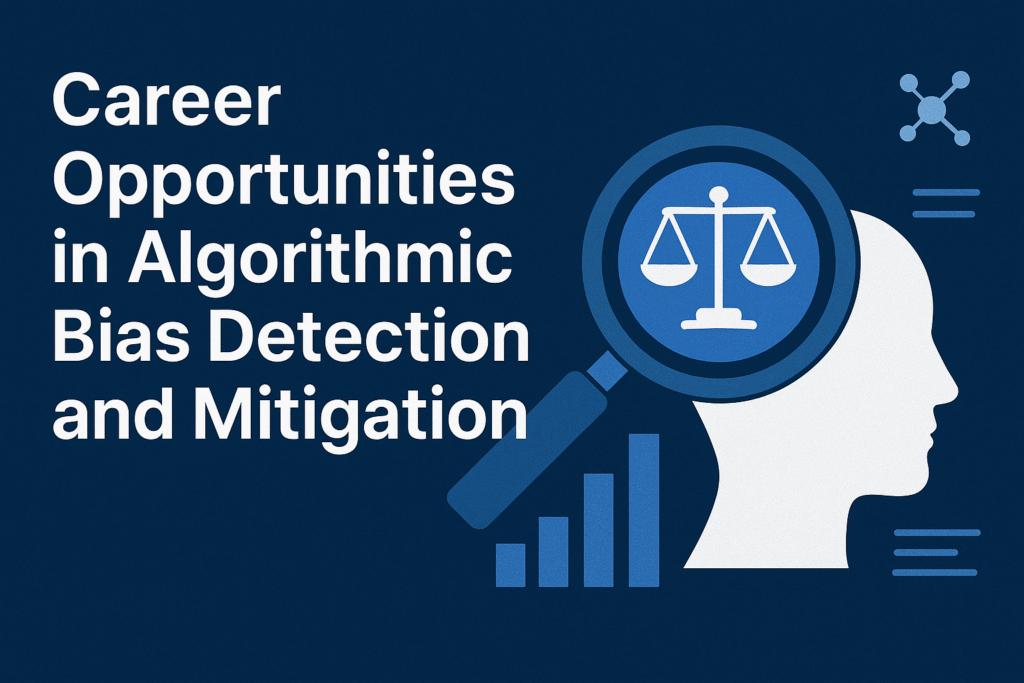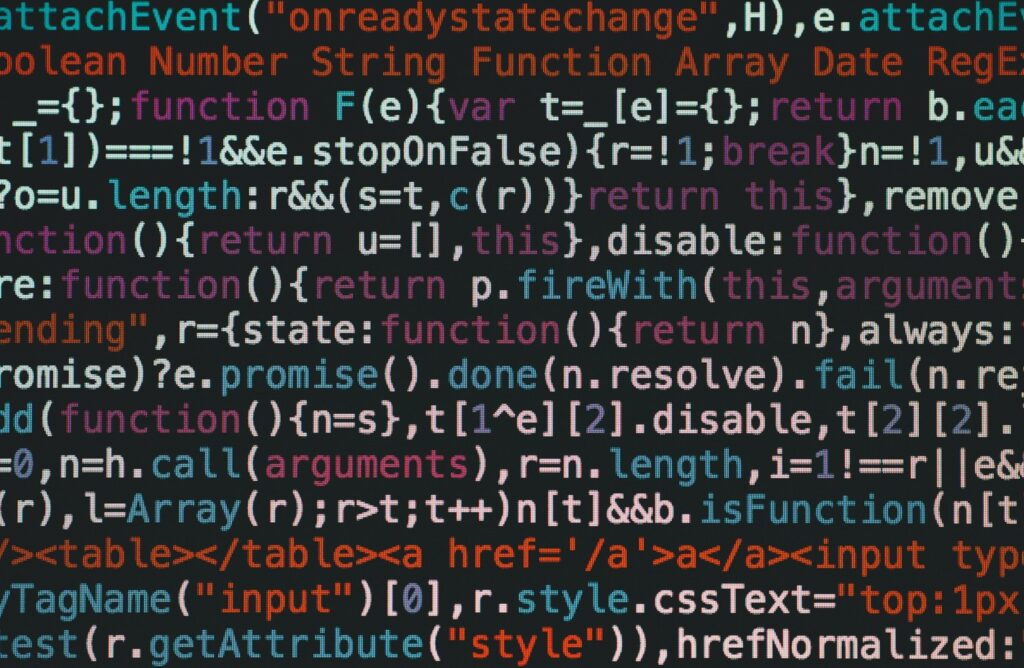Introduction: The Hidden Bias in AI Systems
In the last decade, Artificial Intelligence (AI) has quietly become the decision-maker behind many aspects of our lives — from job recruitment and loan approvals to healthcare diagnoses and criminal sentencing. While these algorithms are often praised for their efficiency, they also hide a troubling flaw: algorithmic bias.
Algorithmic bias occurs when an AI system produces results that are systematically prejudiced due to erroneous assumptions in the machine learning process. In other words, when bias seeps into data or model design, it amplifies inequalities rather than removing them. AI systems are supposed to make neutral, data-driven choices — but in reality, they often reflect the biases of the people who build and train them.

For example:
- A hiring algorithm that favors male candidates because it was trained on historical data where most employees were men.
- A facial recognition model that misidentifies darker-skinned individuals due to underrepresentation in the training dataset.
- A loan approval AI that declines applications from certain neighborhoods because of biased credit history data.
These examples aren’t science fiction — they are real, documented cases that have made global headlines. The result? A growing demand for experts who can detect, measure, and mitigate bias in AI systems before they harm real people.
That’s where a new and critical field of careers has emerged — Algorithmic Bias Detection and Mitigation.
This profession sits at the intersection of data science, ethics, sociology, and law, and it is becoming one of the most in-demand specializations in the AI industry. Professionals in this field ensure that AI systems remain fair, explainable, transparent, and accountable.
As organizations increasingly rely on AI for decision-making, governments and regulatory bodies worldwide are tightening rules around AI fairness and compliance. This has created a massive opportunity for career seekers who want to combine technical skills with social responsibility.
Table of Contents
2. What is Algorithmic Bias?
At its core, algorithmic bias refers to systematic and repeatable errors in AI systems that create unfair outcomes, such as favoring one group over another.
Types of Algorithmic Bias
- Data Bias:
When the data used to train a model does not accurately represent the population.
Example: If an AI model for healthcare is trained primarily on data from men, it may fail to diagnose women accurately. - Sampling Bias:
Occurs when data is collected from a skewed sample.
Example: A model trained only on urban user data might perform poorly for rural populations. - Measurement Bias:
When data attributes are incorrectly measured or labeled.
Example: Police crime data might reflect over-policing in certain areas, making algorithms predict higher crime risks unfairly. - Algorithmic Bias (Design Bias):
When the model’s mathematical structure or optimization goal favors certain outcomes.
Example: A credit-scoring AI might weigh income more than reliability, disproportionately affecting lower-income groups. - Human Bias:
When the developers’ own assumptions influence feature selection or data labeling.
The goal of bias detection and mitigation professionals is to identify and neutralize these forms of bias before they reach end users.
3. How Algorithmic Bias Affects Real-World Systems
Algorithmic bias has far-reaching consequences, especially when applied to high-stakes domains:
a. Employment
AI recruiting platforms are widely used to filter resumes and predict candidate success. However, biased models can:
- Downgrade resumes containing female names.
- Penalize candidates from minority institutions.
- Prioritize language or tone associated with certain demographics.
b. Finance
AI models in lending and credit scoring often rely on data with embedded socio-economic biases. This leads to:
- Unfair loan denials.
- Discriminatory interest rates.
- Higher rejection for minority groups despite good repayment history.
c. Criminal Justice
Predictive policing algorithms have been criticized for reinforcing racial profiling because historical crime data already contains human bias.
d. Healthcare
Medical algorithms can produce inaccurate predictions for underrepresented ethnic groups, sometimes endangering lives.
e. Social Media
Recommendation systems amplify bias by pushing stereotypical or polarizing content, influencing opinions and even election outcomes.
As AI integrates deeper into daily life, the magnitude of bias-related harm grows — creating an urgent need for specialists to monitor and correct it.
4. The Growing Demand for Bias Detection and Mitigation Experts
Global awareness around ethical AI has sparked a hiring wave. Companies, governments, and research institutions are all seeking professionals skilled in bias auditing and mitigation.
Market Trends
- According to LinkedIn’s 2024 Global Jobs Report, “AI Ethics and Fairness Specialists” are among the top 10 emerging roles worldwide.
- Gartner predicts that by 2026, over 60% of large enterprises will employ AI ethics professionals full-time.
- The European Union’s AI Act and the U.S. AI Bill of Rights have mandated transparency and fairness audits, boosting job creation.
- Tech giants like Google, Microsoft, IBM, and Meta have already built internal “Responsible AI” teams.
These trends reveal a massive skill gap — few professionals currently possess the cross-disciplinary expertise needed to bridge technology and ethics.
5. Understanding the Root Causes of Algorithmic Bias
To succeed in this field, you must understand why bias occurs. Bias is not just a technical flaw — it is a social one, rooted in how we collect, represent, and interpret data.
Key Root Causes
- Historical Inequality in Data
- AI systems mirror historical patterns of discrimination.
- If past hiring favored men, future AI hiring will too.
- Data Quality Issues
- Missing, mislabeled, or unbalanced datasets.
- Over-representation of majority classes leads to poor generalization.
- Lack of Diversity in AI Teams
- Homogeneous teams may overlook minority perspectives.
- Improper Feature Engineering
- Inclusion of proxy variables like zip code or gender-coded words can encode hidden bias.
- Optimization Trade-offs
- When accuracy is prioritized over fairness, algorithms may perform better technically but worse ethically.
- Limited Ethical Oversight
- AI models are often deployed without fairness testing due to business pressures.
Professionals who understand these nuances can design systems that minimize harm and maximize fairness.
6. Techniques Used to Detect Bias in AI Models
Bias detection isn’t guesswork — it involves scientific evaluation using measurable fairness metrics and statistical tools.
1. Statistical Parity
Measures whether different groups (e.g., gender, race) receive similar outcomes from a model.
2. Equal Opportunity
Ensures that qualified individuals from all groups have equal chances of favorable outcomes.
3. Disparate Impact Analysis
Checks whether a model’s decisions disproportionately affect protected groups.
4. Counterfactual Fairness
Tests if changing sensitive attributes (like gender or race) alters predictions.
5. Fairness Through Unawareness
Ensures the model does not use protected attributes directly — though it can still learn them implicitly.
6. Feature Attribution
Analyzes which input features most influence predictions, revealing hidden bias.
7. Explainable AI (XAI) Tools
Methods like SHAP (SHapley Additive exPlanations) and LIME help interpret black-box models and spot unfair decision patterns.
Bias detection professionals often use a combination of these techniques to ensure fairness at every stage — data collection, training, validation, and deployment.
7. AI Tools and Frameworks for Bias Auditing
Modern frameworks make bias detection easier and more standardized. Below are widely used tools:
| Tool / Framework | Developer / Organization | Key Features |
|---|---|---|
| IBM AI Fairness 360 (AIF360) | IBM Research | Library with over 70 fairness metrics and bias mitigation algorithms |
| Fairlearn | Microsoft | Python toolkit for fairness metrics and mitigation in ML pipelines |
| Google What-If Tool | Visual tool for inspecting model predictions and fairness trade-offs | |
| AI Explainability 360 (AIX360) | IBM | Open-source toolkit to make AI models transparent |
| Fairness Indicators | TensorFlow | Monitors fairness metrics during model evaluation |
| Ethical AI Toolkit | Partnership on AI | Ethical frameworks for governance and deployment |
| CheckBias.ai | Independent | Automated auditing for AI APIs and datasets |
Mastering these tools is a key requirement for aspiring bias auditors or AI ethics professionals.

8. Major Industries Hiring Bias Detection Professionals
AI fairness is no longer limited to academia — it’s a real business necessity across multiple industries.
a. Technology
Companies like Google, Meta, and Amazon lead responsible AI initiatives, hiring specialists to audit internal and external systems.
b. Finance
Banks and fintech firms need fairness auditors for credit scoring, fraud detection, and KYC algorithms.
c. Healthcare
Bias detection is crucial for diagnostic models, patient risk prediction, and drug discovery tools.
d. Human Resources
Recruiting platforms like HireVue and LinkedIn now employ fairness experts to monitor automated candidate screening tools.
e. Government & Public Policy
Governments use AI for public services, welfare distribution, and law enforcement — areas requiring strict fairness oversight.
f. Education
AI is increasingly used to personalize learning, but fairness experts ensure equal learning opportunities for all demographics.
9. Core Skills Required for Careers in Algorithmic Fairness
To build a successful career, professionals need a hybrid skill set — combining data science expertise with ethical reasoning.
Technical Skills
- Machine Learning Fundamentals
- Supervised and unsupervised learning.
- Bias-variance trade-offs, feature selection, and model evaluation.
- Data Preprocessing and Balancing
- Handling missing or imbalanced data using oversampling or synthetic data generation.
- Statistical Analysis
- Understanding fairness metrics, hypothesis testing, and statistical inference.
- Programming Languages
- Proficiency in Python, R, or Julia.
- Familiarity with frameworks like TensorFlow, PyTorch, and Scikit-learn.
- Explainable AI Tools
- Using LIME, SHAP, or AIF360 for model interpretation.
- Ethical AI Frameworks
- Knowledge of frameworks like OECD AI Principles, EU AI Act, and IEEE Ethics in AI.
Soft Skills
- Critical Thinking: Questioning data sources and model assumptions.
- Communication: Explaining technical issues to non-technical audiences.
- Empathy: Understanding how AI impacts real human lives.
- Collaboration: Working with legal, policy, and engineering teams.
- Ethical Reasoning: Making judgment calls in morally gray scenarios.
Professionals who can merge both sets of skills are among the highest paid in the AI ethics domain.
10. Educational Pathways and Certifications
Although this field is relatively new, several universities and online platforms now offer specialized programs.
Degrees
- Bachelor’s: Computer Science, Data Science, Statistics, or Ethics.
- Master’s / Ph.D.: AI Ethics, Responsible AI, or Computational Social Science.
Recommended Courses
- Ethics of AI – University of Helsinki (free online)
- AI for Everyone – Andrew Ng, Coursera
- Fairness and Accountability in AI – Harvard Online
- Responsible AI Specialization – Microsoft & edX
- AI and Law – Stanford University
Certifications
- Certified Ethical Emerging Technologist (CEET) – CertNexus
- Responsible AI Expert Certification – World Ethical Data Foundation
- Google Responsible AI Associate Certificate (upcoming)
- AI Governance and Risk Management – IBM
Educational credentials demonstrate your commitment to responsible AI — but real-world experience through internships or open-source projects adds greater credibility.
11. Key Job Roles in Algorithmic Bias Detection and Mitigation
As the field of responsible AI matures, organizations are formalizing specific roles to handle fairness, transparency, and ethical governance. Below are some of the most in-demand positions in this domain:
1. AI Ethics Specialist
Overview:
AI Ethics Specialists ensure that all machine learning models and automated systems align with ethical standards, human rights, and legal frameworks. They work closely with both technical and policy teams to evaluate models for potential harm or discrimination.
Responsibilities:
- Conduct fairness audits of AI systems.
- Develop and maintain ethical AI guidelines.
- Collaborate with developers to design unbiased algorithms.
- Liaise with legal and compliance teams to ensure adherence to regulations.
Ideal Background:
Philosophy, data science, or computer science with additional training in ethics or social sciences.
2. Algorithmic Fairness Engineer
Overview:
This is a hands-on, technical role focused on applying fairness metrics and mitigation techniques to existing AI pipelines.
Responsibilities:
- Implement fairness-aware algorithms.
- Analyze data distributions and model outcomes.
- Apply bias mitigation strategies such as re-weighting or adversarial debiasing.
- Collaborate with data scientists to ensure equitable model performance.
Ideal Background:
Machine learning, data engineering, or computer science.
3. Responsible AI Researcher
Overview:
Researchers focus on developing new frameworks and methods for bias detection, explainable AI, and trustworthy ML models.
Responsibilities:
- Design innovative fairness metrics and evaluation methods.
- Publish research papers and build open-source tools.
- Work with academia and industry to advance ethical AI practices.
Ideal Background:
Ph.D. or M.S. in computer science, AI, or computational ethics.
4. AI Policy and Governance Analyst
Overview:
These professionals bridge the gap between technology and law. They analyze government regulations, industry standards, and public sentiment related to AI bias and ethics.
Responsibilities:
- Develop AI governance frameworks.
- Monitor global regulatory developments.
- Prepare compliance documentation for audits and legal reviews.
Ideal Background:
Public policy, law, or management with exposure to data ethics.
5. Data Ethics Consultant
Overview:
Data Ethics Consultants work with multiple organizations as external advisors to ensure responsible AI adoption.
Responsibilities:
- Conduct independent audits of algorithms and datasets.
- Draft ethical guidelines for clients.
- Offer training sessions for employees on bias awareness.
Ideal Background:
Consulting, data analytics, or philosophy with technical awareness.
6. Fairness Data Scientist
Overview:
A Fairness Data Scientist focuses specifically on balancing data and model accuracy with social fairness objectives.
Responsibilities:
- Identify and mitigate dataset imbalances.
- Build interpretable models that explain decisions.
- Conduct post-processing fairness optimization.
Ideal Background:
Statistics, mathematics, or data science.
7. AI Compliance Officer
Overview:
A senior-level professional responsible for ensuring that AI deployments meet ethical and legal requirements such as GDPR, the EU AI Act, and national AI laws.
Responsibilities:
- Oversee fairness, privacy, and accountability audits.
- Collaborate with legal departments.
- Prepare official AI transparency and compliance reports.
Ideal Background:
Law, cybersecurity, or data governance.
8. Explainable AI (XAI) Engineer
Overview:
XAI Engineers focus on creating transparent models and visualizing decision logic in a human-understandable format.
Responsibilities:
- Develop interpretable machine learning systems.
- Use frameworks like LIME, SHAP, and DeepLIFT.
- Design dashboards for transparency in predictions.
Ideal Background:
Computer science, AI, or visualization engineering.
9. AI Risk and Trust Officer
Overview:
These professionals evaluate potential reputational, legal, and ethical risks associated with AI systems.
Responsibilities:
- Conduct risk assessments.
- Monitor ongoing AI model performance.
- Develop organizational trust and accountability reports.
Ideal Background:
Risk management, compliance, or data governance.

12. Average Salaries in Bias Detection and Ethical AI Roles
Below is a detailed comparison of salary ranges across geographies for various job titles in this field (based on Glassdoor, Payscale, and LinkedIn 2025 data):
| Job Title | India (INR/year) | United States (USD/year) | Europe (EUR/year) | Experience Level |
|---|---|---|---|---|
| AI Ethics Specialist | ₹12–24 Lakhs | $90,000–$150,000 | €70,000–€120,000 | Mid–Senior |
| Algorithmic Fairness Engineer | ₹10–22 Lakhs | $100,000–$160,000 | €75,000–€130,000 | Mid–Senior |
| Responsible AI Researcher | ₹14–30 Lakhs | $110,000–$170,000 | €80,000–€140,000 | Senior |
| AI Policy Analyst | ₹8–18 Lakhs | $80,000–$130,000 | €65,000–€115,000 | Entry–Mid |
| Data Ethics Consultant | ₹9–20 Lakhs | $90,000–$140,000 | €70,000–€120,000 | Mid |
| AI Compliance Officer | ₹15–35 Lakhs | $120,000–$180,000 | €90,000–€150,000 | Senior |
| Fairness Data Scientist | ₹10–25 Lakhs | $100,000–$155,000 | €80,000–€130,000 | Mid–Senior |
Note: These figures vary widely by organization size, sector (tech, finance, healthcare), and geography. However, roles focused on AI fairness and ethics consistently offer higher-than-average pay compared to standard data science positions — reflecting their scarcity and societal importance.
13. Top Global Companies Hiring for Bias Detection Roles
The demand for professionals in algorithmic fairness has skyrocketed, with major corporations establishing internal “Ethical AI” or “Responsible AI” departments. Some top organizations actively hiring include:
| Company / Institution | Focus Area | Example Roles |
|---|---|---|
| Google (Responsible AI Division) | Fairness in language and vision models | AI Ethics Researcher, Responsible AI Engineer |
| Microsoft (AI and Ethics in Engineering & Research) | Governance, fairness tools (Fairlearn) | Responsible AI Program Manager |
| IBM (Trusted AI Lab) | Bias detection toolkits (AIF360, AIX360) | Fairness Engineer, AI Research Scientist |
| Meta (Responsible AI Team) | Bias in social algorithms and ads | Responsible ML Engineer |
| Amazon (AI Governance) | Fairness in recruitment and retail recommendation models | Responsible AI Specialist |
| Accenture & Deloitte | AI Governance and Fairness Consulting | AI Compliance Officer, Ethics Advisor |
| OpenAI | Alignment and fairness in large models | Policy Researcher, Bias Auditor |
| SAP, Salesforce, Oracle | Enterprise AI fairness integration | AI Governance Analyst |
| Government AI Taskforces (EU, India, USA) | AI policy and regulation | Policy Officer, Ethics Analyst |
Startups in the “Ethical AI” ecosystem, such as Pymetrics, Parity AI, Truera, and Holistic AI, are also hiring rapidly — often offering remote, research-driven positions with global exposure.
14. Real-World Case Studies of Algorithmic Bias
Let’s explore some notable real-world examples that underline the importance of bias detection and fairness professionals.
Case Study 1: Amazon’s Biased Recruitment Algorithm
In 2018, Amazon discontinued its AI-based recruiting tool after discovering it penalized resumes containing words like “women’s” (e.g., “women’s chess club captain”).
Root Cause: The model was trained on resumes submitted over 10 years — most of which came from men, reflecting the male-dominated tech industry.
Lesson Learned: AI can inherit past human discrimination unless datasets are balanced and fairness constraints are applied.
Case Study 2: Facial Recognition Bias
A 2019 MIT study found that facial recognition systems from major companies had error rates up to 35% for darker-skinned women, compared to less than 1% for white men.
Root Cause: Underrepresentation of diverse faces in training datasets.
Lesson Learned: Diversity in data collection is as crucial as model design.
Case Study 3: Credit Scoring Discrimination
Apple Card came under scrutiny when female applicants received lower credit limits than their spouses, even with better financial profiles.
Root Cause: Gender was not explicitly used, but proxy variables (e.g., spending patterns) indirectly introduced bias.
Lesson Learned: Even when sensitive attributes are excluded, indirect bias can still emerge.
Case Study 4: Healthcare Algorithm Bias
A healthcare algorithm used in the U.S. misidentified patients needing extra care because it relied on past healthcare spending instead of medical need.
Root Cause: Systemic inequality — lower spending among Black patients despite higher medical needs.
Lesson Learned: Biased proxies can worsen healthcare disparities.
Each of these examples emphasizes the urgent requirement for algorithmic auditors, fairness engineers, and compliance officers to intervene before harm occurs.
15. Ethics, Legal Frameworks, and Global Regulations
Ethical AI governance is no longer optional — it is becoming law.
Key Global Frameworks:
- European Union AI Act (2024–2025):
Classifies AI systems based on risk and mandates bias audits for “high-risk” categories (like hiring, credit scoring, and healthcare). - U.S. AI Bill of Rights (2023):
A policy blueprint ensuring AI systems respect privacy, fairness, and transparency. - OECD AI Principles:
Global standard promoting human-centered AI development. - India’s National Strategy for AI (“AI for All”):
Emphasizes inclusive and responsible AI applications across government and industry. - UNESCO Ethical AI Guidelines:
Provides a human rights-based approach for global AI deployment.
Professionals specializing in bias detection and mitigation play a key role in ensuring compliance with these frameworks.
16. Challenges in Building a Career in Algorithmic Bias Detection
While the field offers high potential, it also presents unique challenges:
- Interdisciplinary Complexity
It requires expertise in both technical and ethical domains — a rare combination. - Evolving Legal Landscape
Constantly changing global regulations demand continuous learning. - Limited Awareness
Many companies still undervalue AI fairness until they face public backlash. - Lack of Standardization
No universal fairness metric fits all contexts, making it hard to evaluate objectively. - High Responsibility, High Scrutiny
Ethical roles often involve tough decisions under reputational pressure.
However, for those passionate about making AI fair and inclusive, these challenges make the field intellectually rewarding and socially meaningful.
17. Future Trends in Algorithmic Fairness Careers
Looking ahead, this field is set to grow rapidly over the next decade.
Emerging Trends:
- Bias Auditing as a Service (BAaaS):
Startups offering AI auditing tools and third-party certifications. - Integration with AI Governance Platforms:
Automated compliance systems embedded within machine learning pipelines. - AI Ethics Boards:
More organizations forming internal ethics councils to oversee model deployment. - Global Demand for Explainability:
XAI (Explainable AI) will become a core skill for all ML engineers. - AI Law Specializations:
Lawyers and policy experts specializing in algorithmic discrimination litigation. - Education and Certification Growth:
Universities offering dedicated degrees in Responsible AI and Fair ML. - AI Fairness in Generative Models:
Addressing bias in large language models (LLMs) and image generation systems.

18. Steps to Build a Career in Bias Detection and Mitigation
Here’s a roadmap for aspiring professionals:
Step 1: Learn the Fundamentals
Master machine learning, data science, and ethics through courses, certifications, or degrees.
Step 2: Gain Hands-On Experience
Use open-source datasets to test fairness metrics using AIF360 or Fairlearn.
Step 3: Build a Portfolio
Publish projects showing bias detection or mitigation in action (e.g., fairness audits on public models).
Step 4: Network with Professionals
Join communities like Women in AI Ethics, The IEEE Global Initiative on Ethical AI, or AI4All.
Step 5: Apply for Roles
Target AI governance, compliance, or data ethics positions in tech firms, research labs, or NGOs.
Step 6: Stay Updated
Follow policy updates, read academic papers, and attend conferences such as FAccT (Fairness, Accountability, and Transparency in AI).
19. Why This Career Matters: The Human Impact
At its heart, this profession isn’t just about numbers or code — it’s about ensuring AI benefits everyone fairly.
Bias detection professionals safeguard:
- Job seekers from unfair hiring filters.
- Patients from unequal medical diagnosis.
- Consumers from discriminatory credit scores.
- Citizens from biased surveillance and policing systems.
By pursuing a career in this field, you become a guardian of fairness in the digital age — a voice ensuring that technology empowers rather than excludes.
20. Conclusion: Building a Fairer AI Future
Algorithmic bias detection and mitigation is one of the most transformative and socially responsible career paths of the 21st century. It blends technical mastery with moral purpose — creating professionals who are not just engineers or analysts but ethical innovators shaping the future of AI.
As industries, governments, and societies race toward automation, the demand for fairness specialists will continue to skyrocket. Whether you’re a student, developer, or policy thinker, this field offers a unique chance to build technology that truly serves humanity.
The ultimate goal of bias detection isn’t merely to correct algorithms — it’s to create trustworthy AI systems that reflect our highest values of equality, transparency, and justice.
follow us on whatsapp channel

















